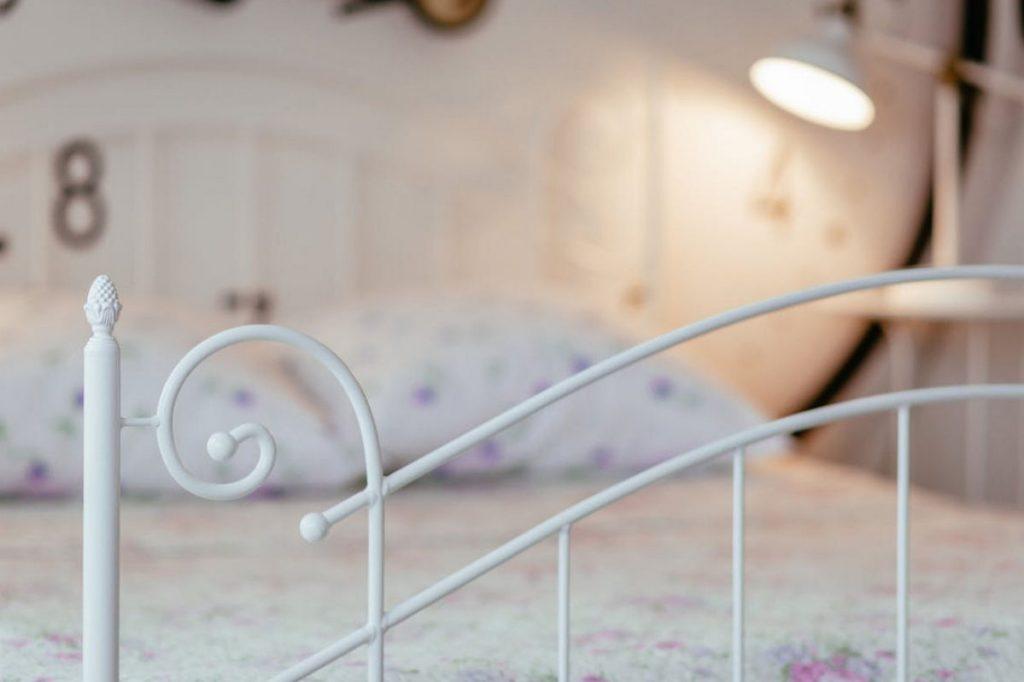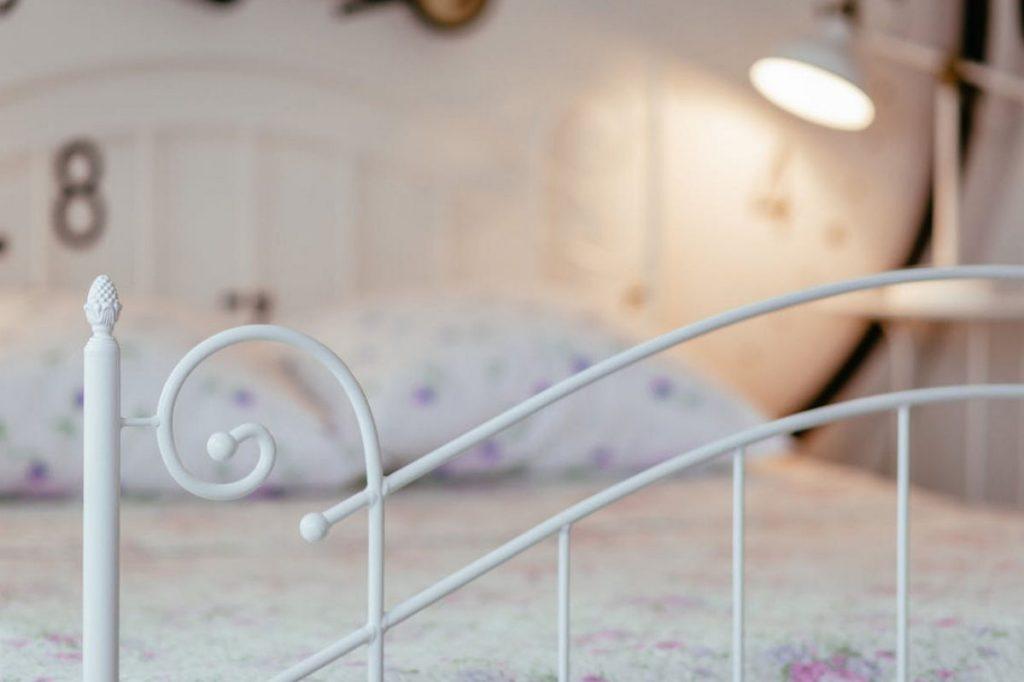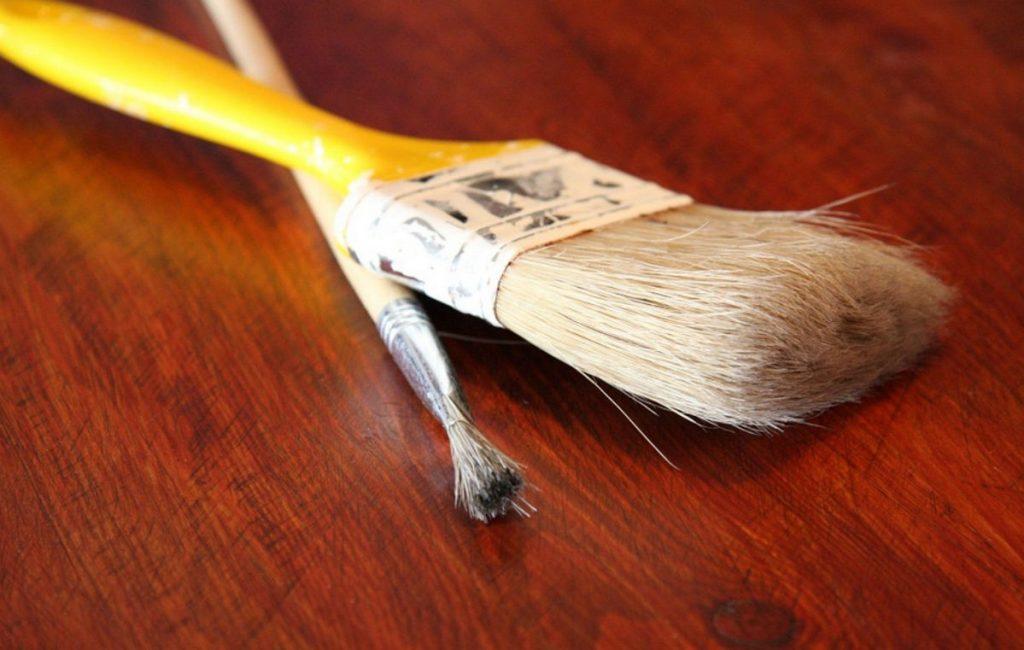Reading Time: 9 minutes
Bed frames are handsome pieces of furniture. As the years go by, there can come a time when you want to refresh it with a lick of paint. In your enthusiasm, you might want to rush straight into the painting part, but whether you can or not depends on the condition of your bed because the bed will need some preparation first. This post guides how to prepare wooden beds and metal beds, paint them, and avoid them when painting a bed frame. We start with metal frames.
How to paint a metal bed frame
You can use two main types of paint on metal surfaces: oil-based paint or water-based acrylic paint. Always look at the packaging of the container to see if the paint is suitable to use on metal. If it doesn’t say it is, don’t use the paint.
Oil-based paint offers a beautiful finish but takes longer to dry. You’ll also need a high-quality paintbrush that doesn’t shed its bristles while painting with it. You can work more quickly with acrylic paints. You can even spray them on.
Preparing a metal bed frame for painting
Proper preparation is the difference between a stellar paint job and a bad one. Follow the steps below to prepare your metal bed frame:
- Clean the frame. If the surface is new, remove grease by using mineral spirits and apply a rust primer to remove rust. If the structure is in good condition, remove the dust with a cloth, lightly sand to degloss the surface, and then apply mineral spirits for better adhesion. Wash with a mild detergent if the dirt refuses to budge. Use a tack cloth to remove any dirt from the sanding.
- Remove loose or peeling paint with a wire brush, sander, or scraper. This is more labour-intensive but will serve you better. Some DIY enthusiasts like to use power tools, but this polishes up the metal, and the paint will find it harder to stick to the frame.
- Get rid of rust. This is essential. Clean off the rust with a brush, sand the frame and apply a rust-inhibitive primer so that the paint sticks to the frame better.
- Fix holes and dents. Sand down to the bare metal and apply a degreaser mixed with mineral spirits. Inject an epoxy-based composite into smaller gaps. Into larger ones, line epoxy filler to the edge of the hole; cut some wire glass mesh roughly an inch larger than the hole; press it into the filler; and fill with epoxy, starting from the edge and working towards the centre.
- Prime the metal for painting. Prime the frame for painting straight after you clean it so that rust, dirt, and dust don’t form on it quickly. If the frame is aluminium, the paint won’t settle well on the frame, so choose a galvanised primer for this and other types of metal to which paint won’t stick well. Iron oxide and zinc chromate primers work well for iron and steel, exterior and internal.

Painting your metal bed frame
Paint your frame in a large, dust-free, well-ventilated space. If you can paint it outside on a sunny day, it is much better. You’ll have less cleaning up to do afterwards.
Please keep all your nuts and bolts in a small container to avoid losing them. You can paint your bed frame with spray paint or with a brush. Here are the steps to follow and do the job the quick way, i.e., with spray paint:
- Dismantle the frame and prop the pieces on bricks, boxes, or crates.
- Spray on a primer if the metal isn’t already coated or is shiny or new.
- Leave to dry, which should take around 10 minutes if you’ve used a spray primer.
- Shake the can hard to mix up the paint.
- Spray the bed frame, holding the spray can 8 to 10 inches from the bed. Keep it moving, either horizontally or vertically, to stop it from dripping.
- Leave the coat to dry. Then turn over the frame or part and spray the other side.
- Add another coat when the coat has dried.
- Add a third coat when the second coat has dried if you want a smoother finish. Go over corners and check no excess paint has been built or that you’ve not missed anywhere.
- Spray the nuts and bolts of the frame the same colour, then place them back into the container when you (re)assemble the bed.
- Paint on a coat of sealer for a long-lasting finish.
Alternatively, you may decide to hand paint your bed frame if you have a respiratory condition that stops you from working with aerosols. Once you’ve prepared the frame, follow the steps below to paint it with a paintbrush:
- Dip the tip of the paintbrush into acrylic or oil-based paint and apply with smooth strokes from left to right. Don’t press too hard, or try to cover the whole frame with one coat.
- Add a primer if the metal isn’t already coated or is shiny, new, or in bad condition.
- Leave the primer to dry, and then paint on the first coat.
- Let the paint dry and add a second coat. Repeat until you’ve covered the frame.
- Paint the nuts and bolts of the frame.
- When the final coat is dry, paint on a coat of sealer, let it dry and reassemble the frame.

How to spray paint a brass bed frame
Brass can start to look a little dated, and you might want to freshen it up. The process is similar to painting other metals but with some slight differences. Follow the steps below to spray paint a brass bed frame:
- Scrub the brass with steel wool. This removes any dirt or corrosion and leaves the frame with a rough surface for painting.
- Wipe away the dirt with a tack cloth. The tack cloth is important. It helps you remove any dirt, corrosion, or debris that might not come away with a paper towel or a lint-free cloth.
- Degrease the frame. Go over the part of the frame you’re going to paint with a degreaser. Then leave for 10 minutes to dry. If there’s dirt, grease, or oil on the frame when you paint it, the paint won’t stick to it correctly.
- Apply a bonding primer. This is the best type of primer for brass. Hold it 6 to 8 inches away from the frame and spray it on. Please leave it to dry for around 24 hours, then paint the frame.
- Add thin coats of paint. Apply the paint in the same way as you applied the primer. Let each coat dry completely before you spray on the next. Avoid using latex paints for brass. They don’t stick as well to the frame. They’re also less durable. An enamel paint would be appropriate here.
- Spray on a protective coat. This should be a clear coat and be safe for metal. Spray on back and forth to apply the coat evenly. It can take as little as 30 minutes to dry.
- Allow the protective coat to dry. Once the protective coat has dried, you can reassemble the bed frame.
How to paint a wooden bed frame
There are different types of finishes when it comes to painting wood:
- Gloss, which has a high sheen.
- Satin, which gives the furniture a muted, mid-sheen finish.
- Eggshell, which has a low sheen and an eggshell-like colour.
Alkyd oil-based paint works best for an everyday wooden bed. It hardens over time, which makes it less prone to scuff marks.
If you’re going to paint a wooden frame, below are the steps to take, with sanding and without:
Painting a wooden frame with sanding
- Clean the frame with some soap and water.
- Remove any dirt or loose paint.
- Lightly sand the frame with 150-grit sandpaper, or if the frame is already varnished, 80-grit sandpaper. Remember, you’re just roughing up the wood for painting. If you don’t add the primer or undercoat – the primer goes on bare wood, whereas undercoats go on wood with a finish – won’t stick to it.
- Add the primer/undercoat and allow it to dry.
- Start painting once the primer/undercoat is dry. Use smooth strokes, painting from right to left.
- Leave to dry. Allow 6 to 8 hours between coats, then lightly sand before painting on the next coat.
- Paint on the next coat and allow to dry for 6 to 8 hours.
- Sand and then paint on a new coat. Repeat until you’ve covered the frame.
- Add on the protective finish.
Painting a wooden frame without sanding
Some people find sanding a hassle. You can paint a finished bed frame without having to sand it first, as long as you prepare the frame in other ways. If you don’t feel like doing any major prep work, you can use chalk paint and follow the steps below:
- Clean the frame. You don’t have to strip off any old paint, varnish, or anything, but you should clean the frame before you can get on with the painting.
- Paint the frame. The beauty of chalk paint is you don’t have to worry about the strokes. You can paint freely. You may have to put on more coats than usual, though.
- Apply some wax. The wax will seal the colour and stop debris and water from getting into the finish. Apply the wax in small sections and use a separate brush.
If your bed frame is in good condition, you can prepare it with a deglosser instead of sanding it. A deglosser, also known as ‘liquid sandpaper, is a chemical solution that removes the layer of gloss from a furniture item so you can start painting it. However, if there are any dents or holes in the frame, it’s better to sand down the frame and repair it than get some deglosser. If the frame is flat, not shiny, and you’re not going to paint it a drastically different colour, you can skip the sanding, priming, and deglossing and get on with the painting.

Mistakes to avoid when painting a bed frame
Completing a DIY task feels like a challenge and an accomplishment. It is. Sometimes, however, you can go about it so zestfully that you make some fundamental errors. Avoid the following when you’re painting your bed frame:
Not using a tack cloth to remove dust and dirt
It’s better to wipe down your bed frame with a tack cloth when you’re getting it ready to paint. Paper towels may leave debris and dust still on the frame. Lint-free cloths can do the same. Wipe away dirt and debris with a tack cloth to be sure of picking it up.
Not disassembling the frame.
If you can disassemble the bed frame without damaging it — i.e., you don’t have to smash it to pieces, and you can put it back together again — you should do so. This makes painting the frame a lot easier. You can paint the flat surfaces more evenly and paint every corner. Note, however, that disassembling the frame to paint it will take up more space.

Choosing the wrong colour
There’s nothing worse than grafting with the paintbrush and/or roller, standing back to admire your handiwork, and realising you’ve painted it the wrong colour. Experts suggest avoiding decorating your bedroom red, bright green, orange, or heavily saturated colours because they can disrupt the room’s serenity. You might want to avoid painting your bed frame in the same types of colours.
You can always start over if you paint your bed frame the wrong colour. Now that you’ve got some painting experience, you might finish the job faster. Using the same finish as before, such as eggshell over eggshell, you won’t have to re-prime the wood. Just clean it and get going.
Underestimating the cost
Painting your frame will be more expensive than you think, and the costs will soon add up.
To paint your bed frame, you’ll need the items below:
- A tack cloth
- Sheets or drape cloths to stop paint from getting on furniture
- A roller
- A roller cover
- A paintbrush
- Primer or undercoat paint
- Main paint
- Deglosser (optional)
- Sandpaper
- Sealer
Still, a small price to pay for the pleasure you get out of bed when you’ve completed the paint job.
A few final words on painting bed frames
Painting bed frames is rewarding, but the result will depend on how much you prepare your frame for painting in the first place. Don’t just skip the preparatory steps and go straight to the painting. Clean the frame first and assess whether it’s in good enough condition to crack on with the painting. If it’s not, you should go about mending any damage, sanding, deglossing, and priming before you lay on the paint.
If you don’t feel like painting your bed frame and would rather buy a new bed, check out our bed frame buying guide for tips on buying a new bed and what to look for. Then feel free to browse our site and place an order if you want to buy one.
Related pages
- Bed Frames – The Complete Buying Guide

